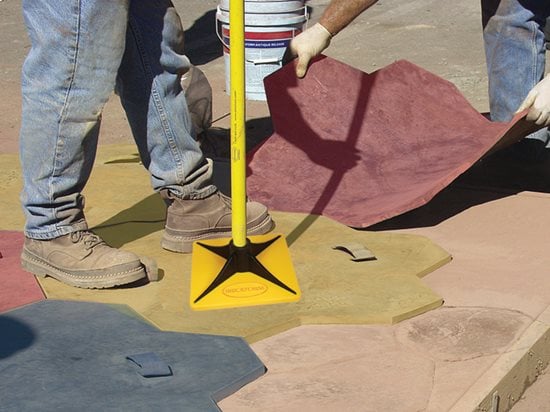- Concrete Stamps
- Get the Look - Stamping Pictures
- Buying Tips for Concrete Stamping Tools: Advice that will help you make smart choices
- Concrete Stamp Cost
- Types of Concrete Stamps: A comparison chart of popular stamps & patterns
- Stamping & Texturing Tools
- Concrete Stamp Mats
- Concrete Texturing Skins
- Medallion Stamps
- Texture Rollers
- Step Forms & Liners
- Installing Stamped Concrete
- How to Stamp Concrete
- Coloring Stamped Concrete
- Concrete Stamp Release Agent
- Sealers for Stamped Concrete
Tampers, Chisels, Rollers and more for Touching Up Stamped Concrete
Tips for buying and using texture mats, chisels, rollers, and tampers to touch up your stamped concrete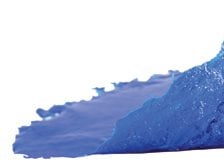
The texture of the touch-up mat must match the large tool and the quality of the frayed edge must be good so it blends in.
The old adage “the devil is in the details” could not be more accurate when it comes to stamped concrete. Detail work is what separates a good stamped concrete job from a great one. Because detail work is such an important part of the stamping process, a large market of dedicated touch-up and detailing tools has developed over the past decade. What started as rudimentary scraps of old stamp tools has slowly given rise to a line of specialized texture mats, tampers, chisels, and rollers for stamped concrete.
Texture MatsHow to use them
Touch-up texture mats are simply smaller, more pliable versions of the larger, more rigid texture mats. These small mats are usually made from a tough but flexible polyurethane rubber to allow the mat to wrap around corners and fit into tight spaces. Touch-up mats are offered in the same textures as standard stamping tools and come in various sizes, ranging from a few inches to a few feet in length and width. Touch-up mats are typically used after most of the main stamping work is complete to texture small areas that may have been missed by the larger stamps, texture awkward or hard to reach spots that the large tools can’t get to, and repair the occasional smear or broken corner.
Features to look for
The most important thing to look at when shopping for touch-up mats is the texture itself, says Brain Farnsworth, director of technical services for Bomanite Group International. “You want the texture of the touch-up tool to match the large tool. The quality of the frayed edge is also important so when you are touching up an area it blends in,” he explains. When purchasing touch-up mats, make sure the tool is made from high-quality rubber, is free from pinholes, and has good texture across the surface.
Chisels and RollersHow to use them
Chisels and rollers are often used at the very end of a stamping job to add the last important details. The tools are typically used together to clean up any rough edges or add in missing grout or cut lines. Touch-up rollers are made from plastic, metal or rigid polyurethane rubber. The roller is usually a few inches in diameter and varies in width and shape, depending on the intended imprint. The roller is attached to a handle that allows for free rolling movement as the tool is pulled and pushed across the concrete.
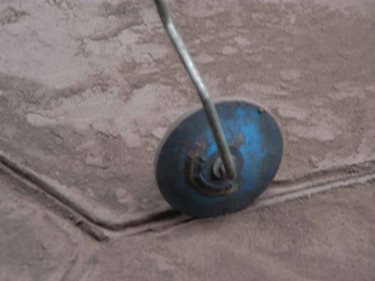
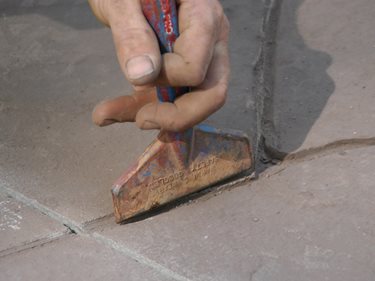 Rollers can be used to clean up any rough edges or add in missing grout or cut lines.
Chisels are used to touch up joint details by making more precise, deeper imprints.
Rollers can be used to clean up any rough edges or add in missing grout or cut lines.
Chisels are used to touch up joint details by making more precise, deeper imprints.
Chisels are most often used for smaller and more accurate detail work, when a straight line or deeper imprint is required. Originally used by stone masons, detail chisels are typically made of cast aluminum and have a broad head and wide blade. Like touch-up rollers, they are available in multiple widths and textures.
Features to look forWhen using a touch-up roller, you want to match the shape and size of the roller head to the stamp pattern being used. The ability of the roller to spin freely and true is the most important feature to look for.
When buying chisels, you should purchase a few tools of various lengths. “The weight of the tool, along with the shape of the blade, are the most important things to look for when selecting detail touch-up chisels,” says Brad Walker, owner of Lonestar Decorative Concrete, Watauga, Texas. The chisel also needs to have some weight to it so it creates an even impression in the concrete with minimal force.
TampersHow to use them
Tampers are often overlooked and not given much consideration as detailing tools for stamped concrete. But in reality, they are very important. Unlike the other touch-up tools, they are used during the stamping process, rather than at the end of the job, to push the stamp into the concrete and produce a better imprint. They consist of a long handle attached to a flat plate that ranges in size from a few inches to a few feet square. The first tampers were simply made of wooden handles attached to a cast iron plate. Most tampers today are made using synthetic materials for both the handle and head, although the original cast iron plate compactor can still be found in use on many stamping jobs. “The heavy, small head is great for working stamp tools into concrete that has gotten hard,” says Farnsworth. When working with concrete that is less firm, it’s best to use a tamper with a larger footprint and made from a softer material, such as polyurethane rubber.
Features to look for
While tampers are simple in design, selecting the right size and shape for the stamping tool can make or break the job. Sturdiness is another important factor to consider when purchasing a tamper. Since the tool will be used to pound stamps into concrete, a strong connection between the handle and head is critical. Weight is also important, since a tamper that is too light will not work well if the concrete starts to get hard.
Related:Medallion Stamps
Return to Concrete Stamps
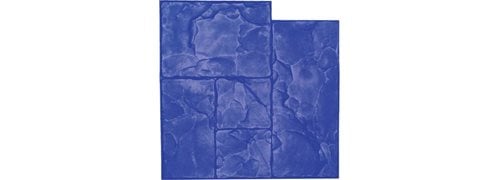 Ashlar Cut Slate Stamp
Hand-tooled with a pronounced texture
Ashlar Cut Slate Stamp
Hand-tooled with a pronounced texture
 Herringbone Used Brick
Tool Size is 44" x 27"
Herringbone Used Brick
Tool Size is 44" x 27"
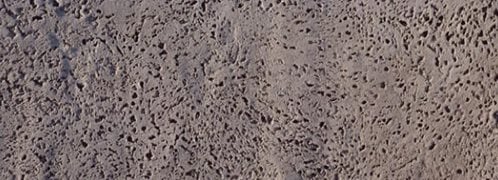 Rock Salt
Seamless travertine off-set
Rock Salt
Seamless travertine off-set
 Bluestone Texturing Skin
6 skin set - only $1,173.20
Bluestone Texturing Skin
6 skin set - only $1,173.20
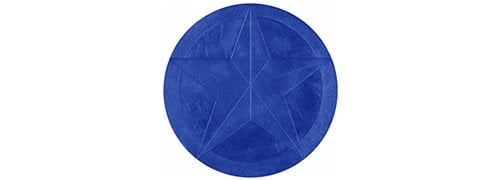 Five Point Star Medallion
Concrete stamp only - $292.00
Five Point Star Medallion
Concrete stamp only - $292.00
 Brickform Stamping Tools
Precision stamping tools
Brickform Stamping Tools
Precision stamping tools
